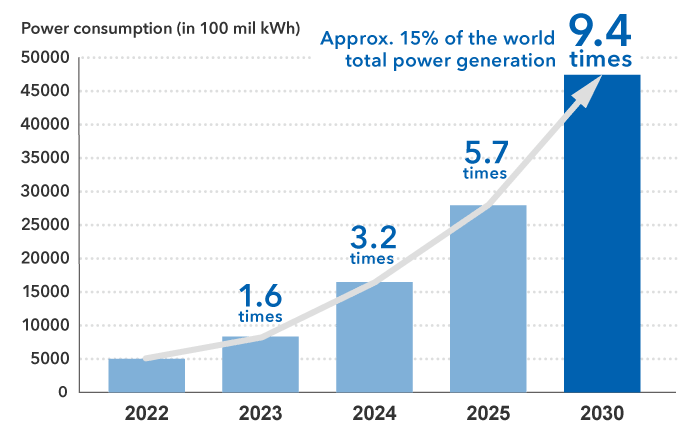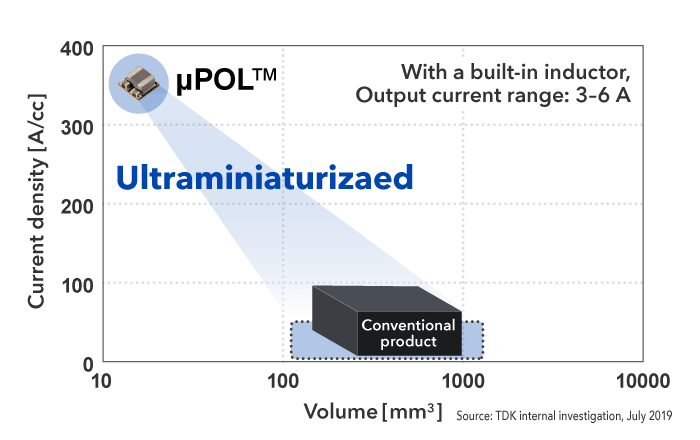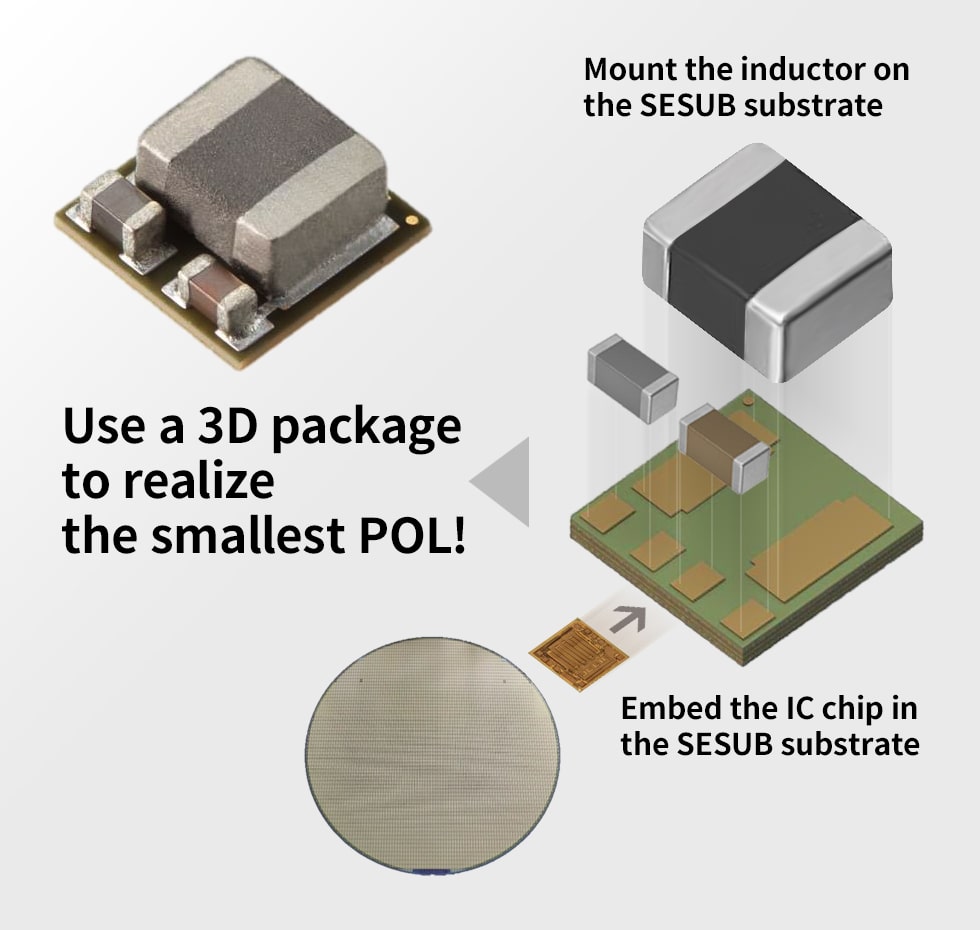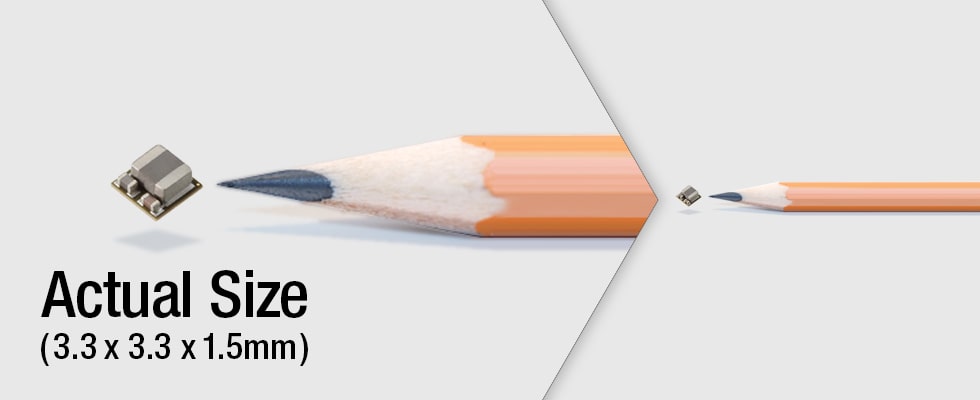Battling Server Overheating, Enemy of Data Centers
Technological Challenges In Reducing Server Heat Generation and Data Center Power Consumption
Data centers are generally required to have a large-volume/high-speed communication environment, advanced security, robust earthquake countermeasure equipment, and an in-house power generator, in addition to room where servers are placed. To maintain operations under these conditions, power consumption is a major challenge.
Projection of data centers’ energy consumption (worldwide)

Source: Estimates by Ministry of Economy in Japan, Trade and Industry/Green IT Promotion Council (2008)
A data center requires a large number of high-performance servers to process larger amounts of data at high speed, which involves increases in power consumption and heat generation, raising the temperature in the data center. Overheating may cause server malfunctions or system failures, and thus requires cooling. However, the air conditioner for cooling these servers also needs electric power, which will further increase power consumption in the data center as a whole. This is a structural issue. Today, society-wide efforts are required to address power saving, as sustainable development goals (SDGs) gain attention. To respond to new sustainability efforts and to also cut costs, data centers face a major challenge in how they can reduce power consumption.
While data centers are making strides to reduce power consumption, including promoting DC feeding and enhancing air conditioning efficiency in the entire facility, a fundamental solution is to reduce the heat generation of servers themselves. As part of this effort, the power efficiency of an electronic circuit, including a semiconductor integrated circuit (IC), which can be understood as the heart of a server, needs to improve. However, a power supply that supplies power to server ICs cannot be placed near the ICs due to its size and thus requires long wiring, resulting in power loss*2 and heat release, which presents a different challenge.
An Ultrasmall DC-DC Converter Solution Reduces the Total Energy Consumption of Servers
To overcome this challenge, TDK recently developed an ultrasmall DC-DC converter*3 (3.3 mm × 3.3 mm × 1.5 mm in size, and 6A in output current), which achieves the best top-class current density in the world with the world’s smallest-class size. This enables placement near ICs and avoids power loss due to wiring, and prevents heat generation by servers. Placing the ultrasmall DC-DC converter near ICs was TDK’s original idea. The product name μPOL™ is a registered trademark; POL stands for "Point of Load" and means nearby placement.
In addition to the small size and high density, it boasts excellent heat release characteristics and has little variation in output related to temperature changes, while conventional products show variations in output current due to self-heating from around 60℃. This enables the product to be mounted even on the back side of a circuit board that has no airflow*4, on which mounting is usually difficult, thereby significantly improving design flexibility. Therefore, the product can save electronic circuit space and reduce the power consumption of the entire system.
μPOL can be effectively used for ICs not only at data centers but also in networks, information/telecommunications, base stations, as well as for ICs in precision equipment such as digital still cameras. It also contributes to serial buses*5 for high-speed data communication, which enable Digital Transformation (DX).
μPOL was developed by Faraday Semi, a US venture company engaging in power supply IC design, which TDK acquired in 2018. This new solution incorporates the high-performance IC developed by Faraday Semi in TDK’s original packaging technology SESUB*6 , and the inductor*7 that utilizes magnetic technology, the origin of TDK’s foundation, by using 3D mounting technology*8. μPOL, which achieves the industry and world’s top-class current density with the world’s smallest-class size, was created using the technological capability and creativity of the venture company, and the core technology of TDK, with an 85 year history.
The world’s smallest DC-DC converter μPOL, which achieves an output current of 6A with a size of 3.3 mm × 3.3 mm × 1.5 mm, and an output current of 12A with a size of 5.8 mm × 4.9 mm × 1.6 mm. Please refer to Product Center for details.
Terminology
- Data center: A general term for facilities/buildings in which IT equipment such as servers and network devices are installed and operated. Among data centers, those specializing in Internet connection used to be called Internet data centers, which, however, are often called data centers these days with the explosive data increase.
- Power loss: Part of electric energy that is lost as heat during power transmission.
- DC-DC converter: The name of a power supply device for converting DC into DC.
- Airflow: It refers to airflow in an electronic circuit. In designing an electronic circuit, the consideration of airflow is generally required to allow ICs and parts to be cooled.
- Serial bus: A channel that exchanges data internally inside the computer or electronic device, and externally between such machines and external equipment is called a bus. A serial bus transmits data sequentially one bit at a time.
- SESUB: Semiconductor Embedded Substrate. A technology for embedding an IC (i.e., semiconductor) in a resin substrate and three-dimensionally mounting a passive component or other parts for modularization.
- Inductor: An electronic component with a coil conductor wound on the magnetic material. It has a role of removing noise, extracting signals of interest, and filtering signals, as well as a function to stabilize voltage.
- 3D mounting technology: A technology for placing semiconductor IC chips in layers to fit them into a package.
Related links
Product inquiries by email




